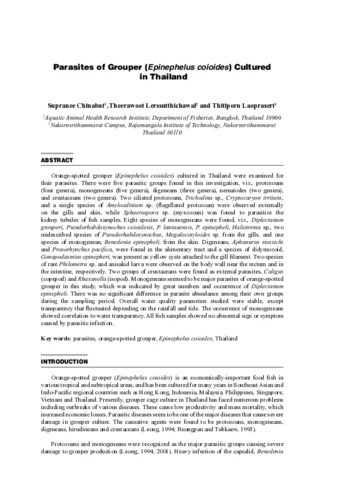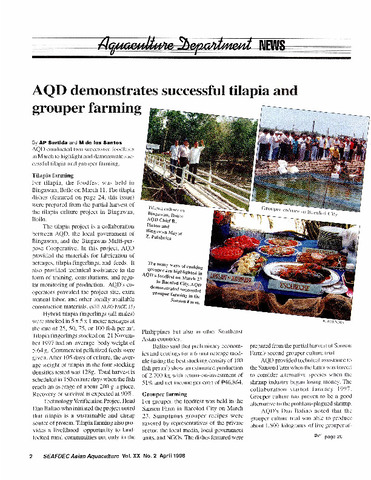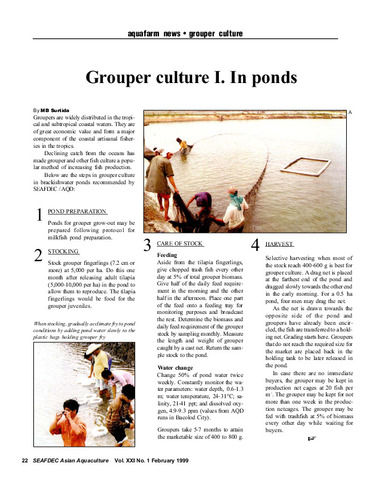Parasites of grouper (Epinephelus coioides) cultured in Thailand
- Global styles
- MLA
- Vancouver
- Elsevier - Harvard
- APA
- Help
Share
抄録
Orange-spotted grouper (Epinephelus coioides) cultured in Thailand were examined for their parasites. There were five parasitic groups found in this investigation, viz., protozoans (four genera), monogeneans (five genera), digeneans (three genera), nematodes (two genera), and crustaceans (two genera). Two ciliated protozoans, Trichodina sp., Cryptocaryon irritans, and a single species of Amyloodinium sp. (flagellated protozoan) were observed externally on the gills and skin, while Sphaerospora sp. (myxozoan) was found to parasitize the kidney tubules of fish samples. Eight species of monogeneans were found, viz., Diplectanum grouperi, Pseudorhabdosynochus coioidesis, P. lantauensis, P. epinepheli, Haliotrema sp., two undescribed species of Pseudorhabdosynochus, Megalocotyloides sp. from the gills, and one species of monogenean, Benedenia epinepheli, from the skin. Digeneans, Aphanurus stossichi and Prosorhynchus pacifica, were found in the alimentary tract and a species of didymozoid, Gonapodasmius epinepheri, was present as yellow cysts attached to the gill filament. Two species of rare Philometra sp. and anisakid larva were observed on the body wall near the rectum and in the intestine, respectively. Two groups of crustaceans were found as external parasites, Caligus (copepod) and Rhaxanella (isopod). Monogeneans seemed to be major parasites of orange-spotted grouper in this study, which was indicated by great numbers and occurrence of Diplectanum epinepheli. There was no significant difference in parasite abundance among their own groups during the sampling period. Overall water quality parameters studied were stable, except transparency that fluctuated depending on the rainfall and tide. The occurrence of monogeneans showed correlation to water transparency. All fish samples showed no abnormal sign or symptom caused by parasitic infection.
Suggested Citation
Chinabut, S., Lerssutthichawal, T., & Laoprasert, T. (2005). Parasites of grouper (Epinephelus coioides) cultured in Thailand. In K. Nagasawa (Ed.), Recent Advances in Diagnosis and Prevention of Fish and Shrimp Diseases in Southeast Asia (pp. 267–279). Tigbauan, Iloilo, Philippines: Aquaculture Department, Southeast Asian Fisheries Development Center.
Type
Book chapterISBN
9718511732
Related items
Showing items related by title, author, creator and subject.
-
AQD demonstrates successful tilapia and grouper farming
Surtida, Augusto P.; de los Santos, M. (Aquaculture Department, Southeast Asian Fisheries Development Center, 1998) -
Grouper culture
Surtida, Marilyn B. (Aquaculture Department, Southeast Asian Fisheries Development Center, 1999) -
The effect of background color and rotifer density on rotifer intake, growth and survival of the grouper (Epinephelus suillus) larvae
Duray, Marietta N.; Estudillo, Chona B.; Alpasan, Lota G. (Elsevier, 1996)Rotifer intake and early growth and survival of Epinephelus suillus larvae were determined in terms of rotifer visibility against the background color of rearing tanks and density. The larvae were stocked at 30 l−1 ...


 AQD Access
AQD Access



